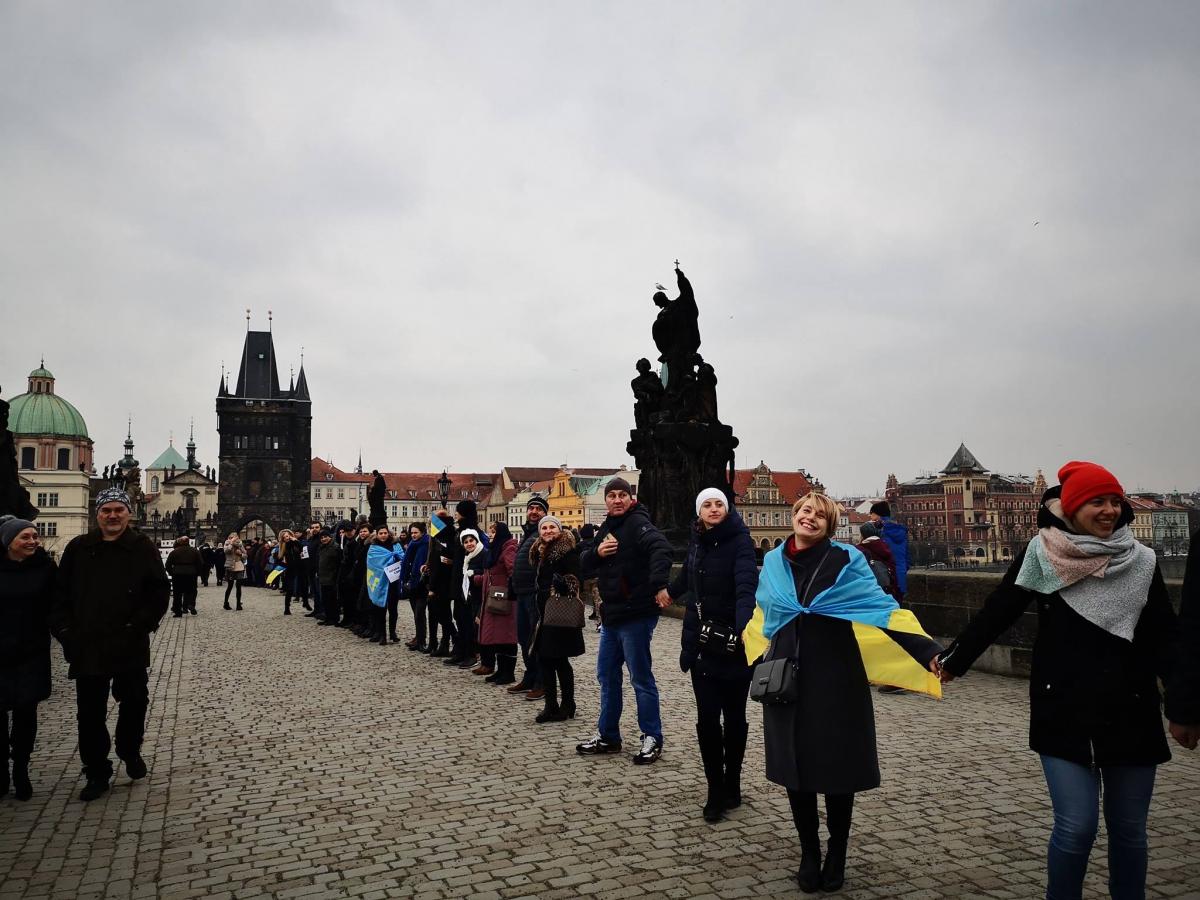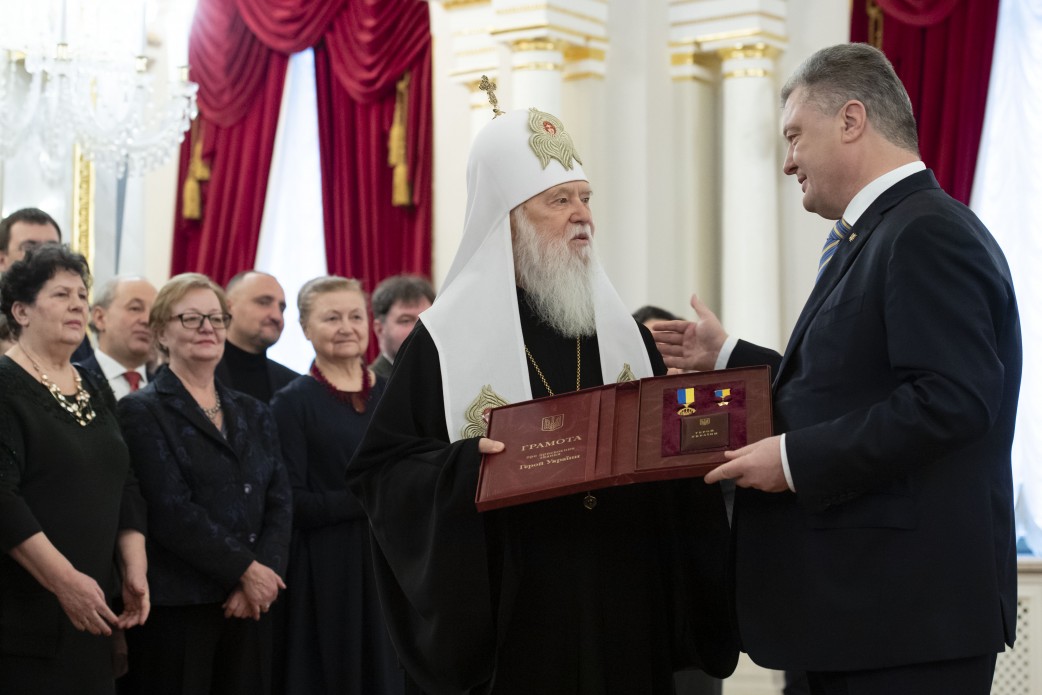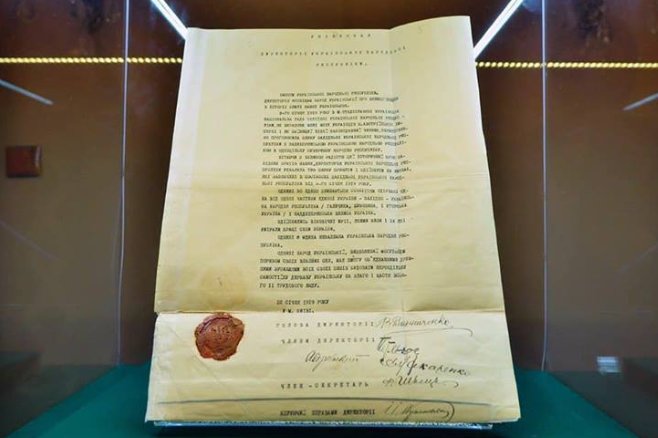In memory of that event, on its 71st anniversary, amid rising national-liberation movements of the collapsing Soviet Union, on 21 January 1990, more than 450,000 of Ukrainians formed the first human chain symbolically uniting the cities of Kyiv, Ivano-Frankivsk, and Lviv.
The memorable date got an official status in 1999, when then-president of Ukraine Leonid Kuchma signed a decree proclaiming the Unification Day of Ukraine a state holiday, celebrated on 22 January. However, there is no day off.
President Petro Poroshenko has reminded today that the 1919 Unification Act of the UNR and ZUNR is "extremely important," and it "became one of the historical foundations for the Act of Independence of Ukraine in 1991."
Stronger together. Ukrainians join for a traditional chain of unity to mark the historic date of unification of the republic in 1919. Happy Ukraine’s Unity Day! ✌️
pics: @UKRINFORM pic.twitter.com/wEy54tTeo8— Ukraine / Україна (@Ukraine) January 22, 2018
Festivities and official ceremonies took place in Ukraine on the occasion of the Day of Unity today. In Kyiv, the head of the state and other officials laid flowers to the monuments to 19th-century Ukrainian poet Taras Shevchenko and UNR statesman Mykhailo Hrushevsky. The first couple paid tribute to the memory of Mikhail Zhiznevsky and Serhii Nihoyan, who were killed on the Unity Day amid the Revolution of Dignity in 2014. The Unity Day celebrations took place on the St. Sofia Square in Kyiv, where the Unification Act between UNR and ZUNR was proclaimed 100 years ago.
Ukrainians formed a human chain across the Dnipro River on Kyiv's Paton Bridge to symbolically unite Right-Bank Ukraine and Left-Bank Ukraine - historical and territorial names for parts of modern Ukraine on the right (western) and left (eastern) banks of the Dnipro River.
Concerts, parades, and presentations for Unity Day, even an exchange of symbolic bread. In the spirit of Unity, let's take a look now at how Ukrainians around the country are celebrating this day pic.twitter.com/MlgrgD2pqI
— UATV English (@UATV_en) January 22, 2019
So what happened a century ago?
100 years ago
Read more on the history of the Unity Act in our 2016 article Ukrainians worldwide to commemorate Act of Unity on January 22
UNR
The Ukrainian National Republic (UNR), a predecessor of modern Ukraine, was declared in Kyiv on 10 June 1917 initially as part of the Russian Empire's successor - the Russian Republic. Later on 25 January 1918, UNR proclaimed its independence. The state included most of the regions of modern Ukraine,
One important diplomatic action of UNR was signing the Brest Agreement in February 1918 with the countries of Quadruple Alliance, which defined UNR as an independent state. It was also recognized by Romania.
The UNR existed on Ukrainian territory until 1920, when the UNR government went into exile. The military forces of the Republic fought in the Ukrainian territory until 1921.
The state fell to the Russian invasion and was officially incorporated in the USSR in 1922 as one of its founding members, the Ukrainian Soviet Socialist Republic.
The Ukrainian government-in-exile existed until Ukraine re-gained independence in 1991. The last President of the Ukrainian People's Republic in exile, Mykola Plaviuk, handed over his presidential powers to Leonid Kravchuk, the first president of independent Ukraine.
Read more on the UNR:
- Ukraine marks the 100th anniversary of independence of Ukrainian People’s Republic (2018)
- National museum exhibits documents from first Ukrainian republic
- The Ukrainian Revolution of 1917 and why it matters for historians of the Russian revolution(s)
- 83-86% of the Black Sea Cossacks in Kuban region were Ukrainian
- How the UNR Army liberated the Donbas in 1918
- Unique 1919-1920 map of Ukraine exhibited in Prague
- Ukrainian history gift to global history – Prof. Snyder
ZUNR

A large part of the territories of modern Ukraine, in particular, the regions of eastern Galicia, Bukovyna and Transcarpathia, were part of the Austro-Hungarian Empire which ceased to exist in October 1918 following its defeat in the First World War. Like other nations of the Empire, Western Ukrainians started creating their own state.
On 18 October 1918, in Lviv at the meeting of all Ukrainian deputies of Austrian Parliament, Ukrainian members of Galicia and Bukovyna Seims, representatives of the parties of Galicia and Bukovyna, clergy and students created the Ukrainian National Rada (a Council) which became a political representative body of Ukrainian people in Austro-Hungarian Empire.
A Ukrainian government took power on 1 November 1918 in Galicia, days later in Bukovyna and in Transcarpathia. The National Rada established the Ukrainian nation-state of the Western Ukrainian National Republic (ZUNR) on 9 November 1918 amid the Polish–Ukrainian War.
The Western Ukrainian National Republic lasted just several months until July 1919.
Unity Act
The preliminary agreement between ZUNR and UNR to unite western Ukraine with the rest of the country was concluded on 1 December and on 22 January 1919 the act was signed in Kyiv. The act was mostly symbolic since both governments still retained their own separate armies and administrations, and the union has never been implemented because ZUNR was invaded by Poland and later by Romania, and UNR by Soviet Russia, thus both Ukrainian states ceased to exist. The territories of the former ZUNR were annexed by the USSR in 1939-1944 and appended to the Ukrainian Soviet Socialist Republic.
Thus at the moment when Ukraine proclaimed its independence in 1991, most of the territories of UNR and ZUNR were already incorporated in Ukraine.
"A century ago, the unified state couldn't defend itself. Though the historical Unification of the Ukrainian lands striving for the unity and independence, continued to inspire generations of Ukrainians to struggle for achieving these dreams. And this struggle was crowned with success."







